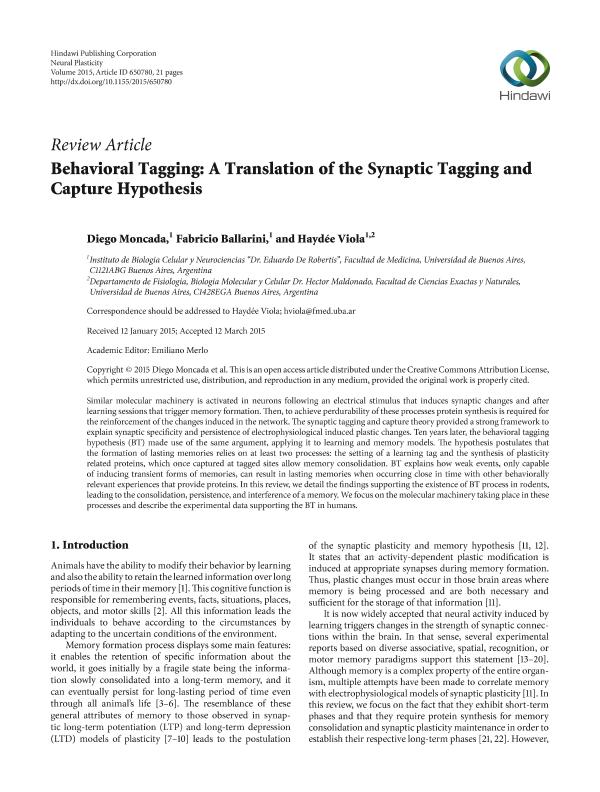Artículo
Behavioral Tagging: A Translation of the Synaptic Tagging and Capture Hypothesis
Fecha de publicación:
08/2015
Editorial:
Hindawi Publishing Corporation
Revista:
Neural Plasticity
ISSN:
2090-5904
e-ISSN:
1687-5443
Idioma:
Inglés
Tipo de recurso:
Artículo publicado
Clasificación temática:
Resumen
Similar molecular machinery is activated in neurons following an electrical stimulus that induces synaptic changes and after learning sessions that trigger memory formation. Then, to achieve perdurability of these processes protein synthesis is required for the reinforcement of the changes induced in the network. The synaptic tagging and capture theory provided a strong framework to explain synaptic specificity and persistence of electrophysiological induced plastic changes. Ten years later, the behavioral tagging hypothesis (BT) made use of the same argument, applying it to learning and memory models. The hypothesis postulates that the formation of lasting memories relies on at least two processes: the setting of a learning tag and the synthesis of plasticity related proteins, which once captured at tagged sites allow memory consolidation. BT explains how weak events, only capable of inducing transient forms of memories, can result in lasting memories when occurring close in time with other behaviorally relevant experiences that provide proteins. In this review, we detail the findings supporting the existence of BT process in rodents, leading to the consolidation, persistence, and interference of a memory. We focus on the molecular machinery taking place in these processes and describe the experimental data supporting the BT in humans.
Palabras clave:
MEMORY
,
BEHAVIORAL TAGGING
,
SYNAPTIC TAGGING
Archivos asociados
Licencia
Identificadores
Colecciones
Articulos(IBCN)
Articulos de INST.DE BIOLO.CEL.Y NEURCS."PROF.E.DE ROBERTIS"
Articulos de INST.DE BIOLO.CEL.Y NEURCS."PROF.E.DE ROBERTIS"
Citación
Moncada, Diego; Ballarini, Fabricio Matias; Viola, Haydee Ana Maria; Behavioral Tagging: A Translation of the Synaptic Tagging and Capture Hypothesis; Hindawi Publishing Corporation; Neural Plasticity; 2015; 8-2015; 1-22
Compartir
Altmétricas




